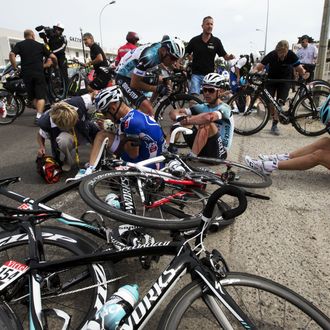
We’re three stages into the 100th Tour de France, and if you’re wondering why you should care, especially after Lance Armstrong’s Oprah confession, it’s because this merde has been insane.
The madness began on the opening day in Corsica, less than six miles from the end of the course, when a late-arriving bus from the Australian team Ornica-GreenEdge got wedged under the metal scaffolding marking the finish line, completely and dangerously blocking the road as a swarm of very fast sprinters was bearing down. (Here’s a hilariously bleeped video from inside the Ornica-GreenEdge team car as the fiasco unfolded.)
The bus needed to get unstuck, and fast. The fire brigade was called. Hydraulic equipment was brought in. The air was let out of the tires. Nothing worked. “I’ve seen a lot of things in the Tour de France, but I’ve never seen anything like this,” said announcer Paul Sherman.
Panicking tour organizers decided to move the finish line forward by two miles. But — zut alors! — there was a curve in the road at that spot, which would have meant riders would be sprinting around a blind corner. Tour organizers quickly reversed themselves and reannointed the original finish line. Team managers frantically radioed the change and then the reversal. Meanwhile, the bus was backing up onto the course, which was curvy, barricaded, and filled with spectators. No one was sure if there would be a spot where it could pull over before the riders reached it.
Then with the peloton less than three miles from the finish and closing in at nearly 40 mph, things really went bad, as a massive pileup took out every major sprinter in the race. It started with big-time sprinter André Greipel trying to blast ahead through the pack. Another rider’s pedal caught on his derailleur, ripping it off. While Greipel escaped with just a broken bicycle, carnage reigned in his wake. World time-trial champ Tony Martin went down hard, bruising a lung and suffering a concussion that caused him to lose consciousness twice on the way to the hospital. (Neurologists will cringe to know he was back on his bike the next day.) Mark Cavendish and Peter Sagan, two of the best sprinters in the world, were downed and bloodied, as was former champ Alberto Contador, back for the first time since a drug suspension that stripped him of his third Tour title.
Suddenly, a 25-year-old German sprinter named Marcel Kittel, the fastest guy ahead of the crash, was wearing the yellow jersey in the centennial Tour de France.
Stage two saw a heart-stopping finish sprint with Belgian Jan Bakelants winning by one second. By then Kittel was nearly 18 minutes back, a victim of Corsica’s steep mountains, and stood in 169th place. In today’s stage three, Team Ornica-GreenEdge saw a redemption of sorts, as squad rider Simon Gerrans claimed the leg and the team’s motorized vehicles didn’t cause any scenes.
Next up, the team time trial, which may actually matter in the overall standings. We will, of course, update you if anyone else bites it hard.





























